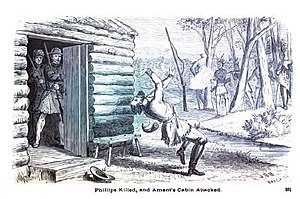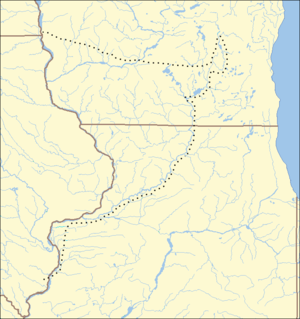Attack at Ament's Cabin
| Attack at Ament's Cabin | |||||||
|---|---|---|---|---|---|---|---|
| Part of the Black Hawk War | |||||||
 An 1887 depiction of the attack | |||||||
| |||||||
| Belligerents | |||||||
|
| Potawatomi | ||||||
| Strength | |||||||
| 7 | 30 | ||||||
| Casualties and losses | |||||||
| 1 KIA | 0 | ||||||
The Attack at Ament's Cabin was an event during the
Background
The site of Ament's cabin was settled in 1829 when John L. Ament and his brother Justin staked claim on adjacent claims
As a consequence of an 1804 treaty between the
Prelude
| Map of Black Hawk War sites Symbols are wikilinked to article |
Before the raid at the cabin, animosity already existed between Ament and the band under Meommuse at the sugar camp. Meommuse's historical use of the camp contributed to his and his band's anger over Ament building his cabin in such close vicinity. The bad blood had already boiled over at least once: Ament had shot one of the band's dogs.
About two weeks after fleeing their cabins, a party of seven men, Elijah Phillips, J. Hodges, Sylvester Brigham, John L. Ament, Aaron Gunn, James G. Forristall and a 16-year-old named Ziba Dimmick left
The band at the sugar camp was notified of the settlers' return to the cabins by a young warrior who had observed them arriving. While the settlers ate dinner, a group from the sugar camp quietly concealed themselves in the underbrush and approached Ament's cabin undetected. There were Potawatomi among the band, one of whom was a son to Chief
Attack
The next morning, either June 17 or 18, the band of about 30 Native Americans returned to their hidden positions and awaited the settlers.
The other settlers rushed into the cabin as the raiding warriors surrounded the house. They shut the door and aimed their weapons through cracks in the walls.[2] Two of the men stood near the doorway with their weapons, and Hodges' weapon came into contact with Girty's chest causing him, and his group, to retreat into the woods.[2][5][6] Young Dimmick, anxious to the point of begging to leave, was then dispatched to Hennepin by horseback for help.[5][6] The men at the cabin expected Dimmick to be shot as soon as he rode off, but he crossed the open prairie unscathed.[5] Dimmick made the 16 mile (25.7 km) journey and arrived in Hennepin to report the attack.[2]
Aftermath
Dimmick's report of the incident was not well received by the people of Hennepin; it caused a general panic as citizens were convinced that
When the Rangers arrived at the cabin site they found the Ament and the other men safely barricaded inside the cabin. Ament waved a white flag through the roof to signal the soldiers as they approached.[2] Outside, they found the undisturbed body of Phillips lying where he had fallen, in the dooryard with his face upturned.[6] He had been shot through the left side of his chest and through the stomach. His body was badly tomahawked, and had slashes across one eye and his neck.[5][6] He had not, however, been scalped.[5][6] The Rangers formed a small detachment and set off in pursuit of the attackers but they soon gave up and returned to Hennepin with Phillips' remains. The funeral took place the next day and was attended by citizens and soldiers alike.[6]
References
41°28′17″N 89°23′43″W / 41.47139°N 89.39528°W
- ^ Past and Present of Bureau County, Illinois, "History of Berlin," Pioneer Publishing, Chicago: 1906, p. 118. Retrieved 4 October 2007.
- ^ a b c d e f g h i j k l m n o p q r s Matson, Nehemiah. Memories of Shaubena, (Google Books), D.B. Cooke & Co.: 1878, pp. 226–34. Retrieved 4 October 2007.
- ^ a b Lewis, James. "The Black Hawk War of 1832 Archived August 15, 2009, at the Wayback Machine," Abraham Lincoln Digitization Project, Northern Illinois University. Retrieved August 1, 2007.
- ^ "May 14: Black Hawk's Victory at the Battle of Stillman's Run Archived 2007-08-14 at the Wayback Machine," Historic Diaries: The Black Hawk War, Wisconsin State Historical Society. Retrieved 6 August 2007.
- ^ a b c d e f g h i j k l m Armstrong, Perry A. The Sauks and the Black Hawk War (Google Books), H.W. Rokker: 1887, pp. 399–403. Retrieved 4 October 2007.
- ^ a b c d e f g h Matson, Nehemiah. "Killing of Phillips," Map & Sketches of Bureau County, ILL, via Tampico Historical Society, p. 22. Retrieved 4 October 2007.

